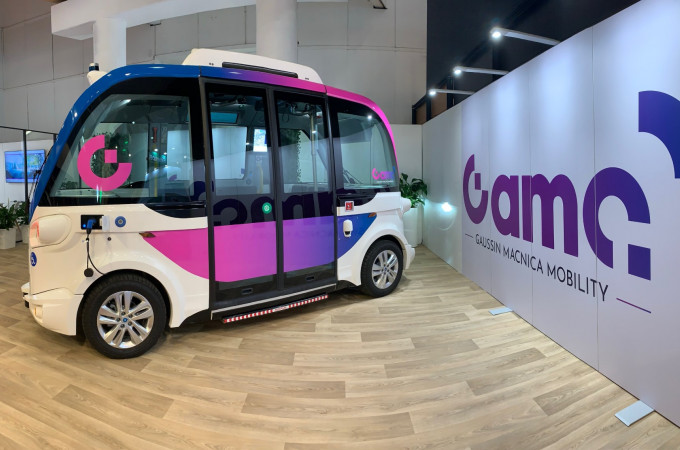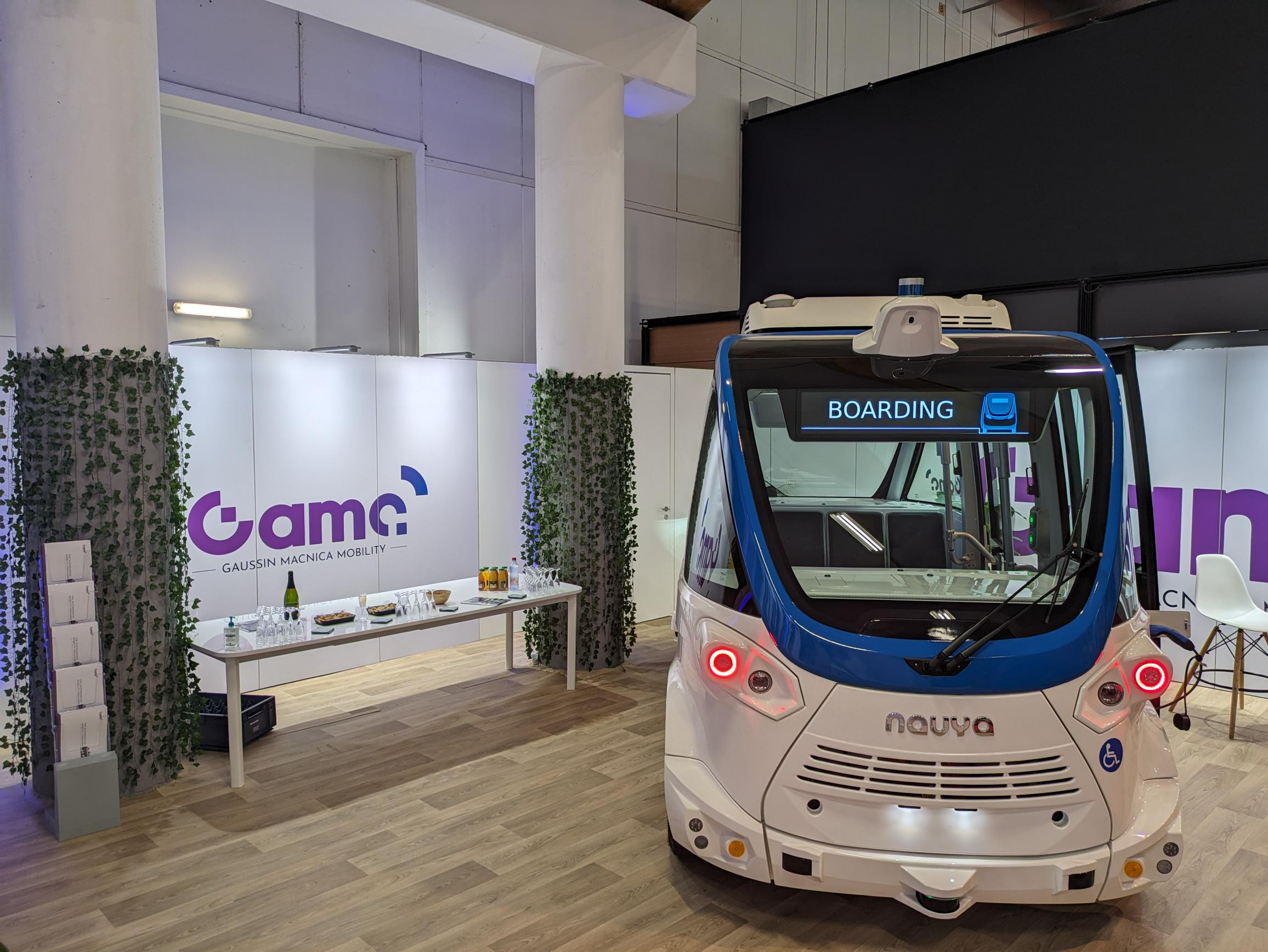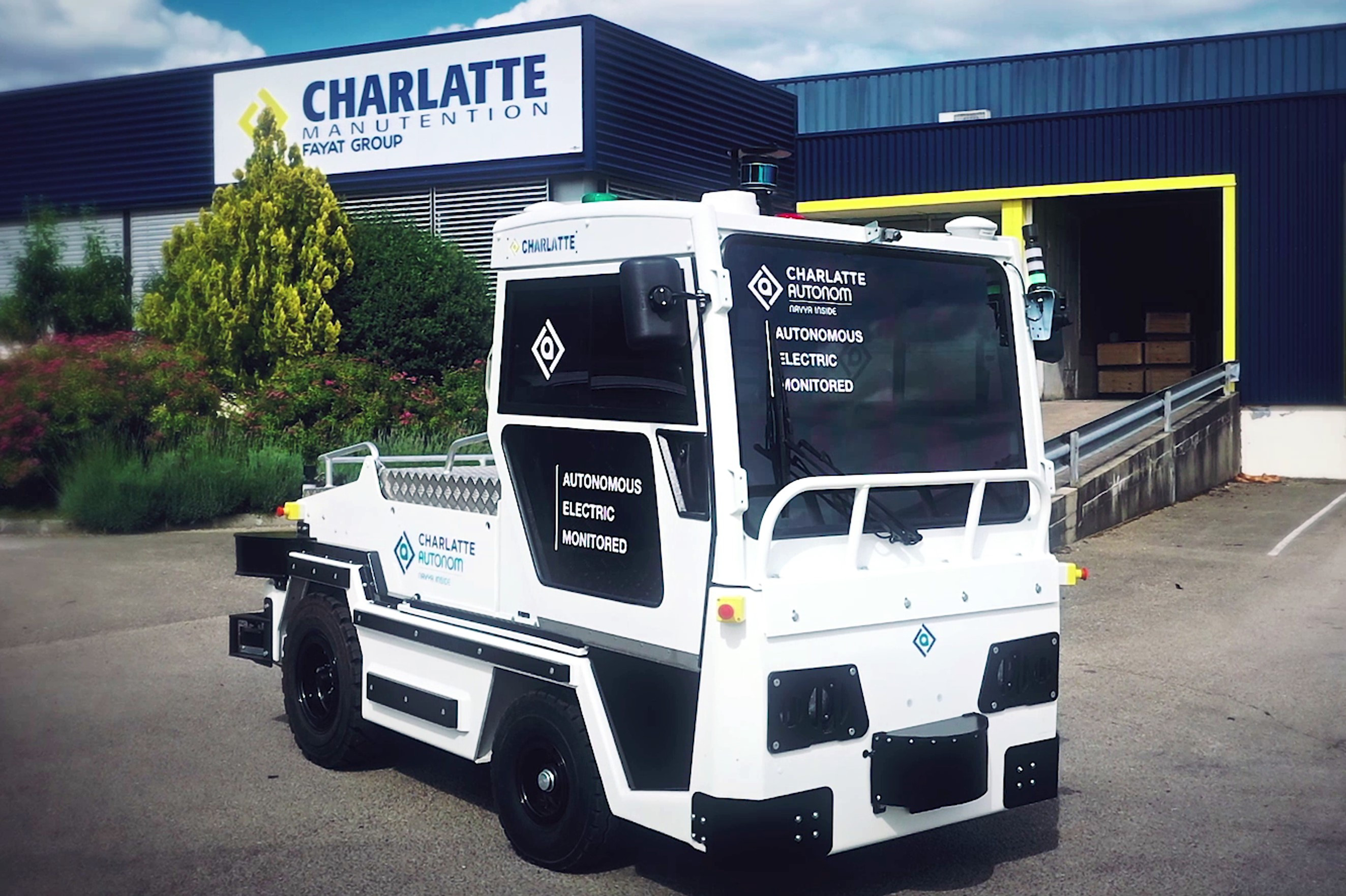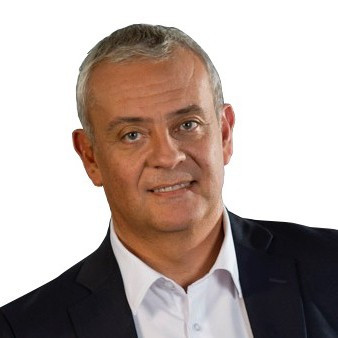The dream of autonomy: a T&BB interview with Jean-Claude Bailly, CEO of French self-driving company Gama
By Bradley Osborne - 12th December 2023

Gama autonomous shuttle at Busworld 2023
France – A startup cannot live on ideas alone, no matter how good; it must be able to turn them into a viable business case if it is to remove its dependency on investor funds. That was the message of Jean-Claude Bailly, who took over the ailing French tech company Navya SA when it was saved from insolvency earlier this year by Gaussin and Macnica,1 during an interview with Truck & Bus Builder. Bailly emphasised that the financial woes of Navya were not reflective of the quality of its technology. Since 2014, Navya had developed and refined its self-driving software through numerous pilots in Europe, North America, and Japan; by 2023, it had delivered approximately 220 autonomous shuttles, a considerable achievement when one bears in mind the relative immaturity of the technology. Navya’s dream was to put driverless vehicles on public roads, but its focus was too narrow and its applications too niche for it to turn its technological feats into commercial success.
Bailly is now CEO of Gaussin Macnica Mobility, or ‘Gama’ for short, a new joint venture built from the assets of Navya following their acquisition by Gaussin and Macnica. Coming to the business directly from his role as lead of truck and bus at Gaussin and bringing over a decade of experience at Renault Trucks and Volvo, Bailly is no starry-eyed dreamer or peddler of science-fiction scenarios. His priority is to turn the legacy of Navya’s research and development into a business that can support itself. With its crew of software engineers and researchers brought over from Navya, the workforce of Gama is quite different from the teams which Bailly has led in the past, and the technology itself presents a formidable learning curve. But Bailly remains unfazed: “personally, I’ve worked in really different companies – I started my career in the elevator business within Schindler. And then I also spent seven years in a construction company called Spie Batignolles. […] Every company, of course, is different.” However, in the end, there are no big differences in “what you have to do to make a company successful.”
Nevertheless, the original vision of driverless vehicles on public roads remains firmly in place on the roadmap of Gama. While the company’s new strategy is to expand its focus to include more remunerative opportunities, its researchers are still hard at work on developing a Level 4 passenger shuttle which can operate on public roads with minimal supervision. Bailly is able to give the usual commercial justifications for autonomous vehicles – improved safety, lower costs, greater efficiency – but he can also see how, in concert with other digital technologies, the self-driving shuttle has the potential to revolutionise urban transportation. Between the taxi and the bus, there is room for something that can be “a little bit smaller”, that can navigate “more easily in the city”, and which can be ordered via an app: “clean transport on demand”. These are emphases which I think reflect the French, even the European, sensibility, and the especial importance which is attached to urban transportation that provides a pleasurable experience for all. The autonomous shuttle, which replaces the car and moves alongside other forms of public transport, represents a cleaner, quieter, less obstructive and more convenient alternative which can contribute to “the comfort of life”, or la douceur de vivre, in the city.
As a French company, Gama is subject to the European legal framework on autonomous vehicles, and while the European Union is working on regulations for vehicle autonomy, Bailly feels that it needs to move more quickly. It also needs to allow more trials to happen on the road before the final regulations are in place, which is bound to take a very long time, in Bailly’s view. He is pleased, however, with French government support for its homegrown tech companies. In the past, “quite a lot of people left France to go to Silicon Valley”, and so the government is pushing to keep more software engineers at home. Though Paris remains the centre of tech development in what is still a rather “centralised country”, there are other hubs dotted around which are receiving governmental support. In Villeurbanne and the wider Lyon area, where Gama is based, there is a growing tech industry, and the greater region of eastern France is also an important centre for the nascent hydrogen economy. “We are starting to lose a little bit our very old industrial approach as we move towards more services and tech,” said Bailly.
Gama employs a total of 140 people in France and Singapore, an overseas office which was retained when Navya was acquired by Gaussin and Macnica. A team of workers based in Michigan in the United States was let go following the acquisition. Bailly told T&BB that Gama is currently looking to recruit 50 more workers. While the dream of the fully autonomous vehicle remains the company’s eventual goal, the immediate focus is to develop commercial opportunities in applications that won’t need to wait on the results of intensive research and the slow movement of the EU regulatory machine. In order to survive, the autonomous driving company will need to find a way to become financially autonomous.
Background to Navya and acquisition by Gaussin & Macnica
The history of Navya is tied up in the development of the ‘Autonom Shuttle’, a self-driving electric vehicle able to carry up to 15 passengers. It was launched in 2015 and has since been used in various projects across the world. In 2022, T&BB reported2 that the shuttle had been tested at the UTAC site in Linas-Montlhéry, where it was put through scenarios involving roundabouts, intersections, bike lanes, bus lanes, parking areas, signs, and level crossings. Navya said that the tests had successfully validated the shuttle’s sensors, identification algorithms, and braking triggering, not only proving its ability to perform safely in particular scenarios but also providing useful data towards the remote supervision of Level 4 autonomous fleets in a real urban environment.

Front view of Evo Shuttle
Gama has retained the shuttle which put Navya’s name on the map of autonomous vehicle development, renaming it ‘Evo Shuttle’. However, the essential carryover from Navya to Gama is not the shuttle itself but the software which drives it, renamed from ‘Navya Drive’ to ‘Gama Drive’. In addition, the new company took over Navya’s remote supervision and fleet management tools, which are now called ‘Gama Operate’.
The technologies which Gama has inherited are a testament to the considerable effort which Navya put into developing a truly Level-4 autonomous vehicle. “At the same time,” Bailly said, “having a very very strong focus on that and not enough on sales and revenue” was “difficult to maintain without big financing.” As a result, in January 2023, Navya opened receivership proceedings after declaring that it could no longer meet its financial liabilities. The Lyon Commercial Court accepted the company’s request and set a deadline for the submission of takeover bids to the receiver. The deadline was extended once until, in April, Gaussin came in with an offer to purchase some of the company’s assets for EUR1.4m. On 24 April, Gaussin agreed to a joint takeover with Macnica, with Gaussin taking 51% ownership and Macnica 49%.
Gaussin, which makes terminal tractors and other vehicles based on its electric “skateboard” platform, is fairly well known in the commercial vehicle industry. Macnica, on the other hand, is a less familiar name, though its business is far larger. With an approximate turnover of USD10bn last year, the Macnica Group of Yokohama, Japan is first and foremost a producer of semiconductor components. “Smart mobility” is a more recent topic of interest to the group, and over several years it has built up a division dedicated to research and development in this subject. The decision to enter into a joint venture with Gaussin based on developing Navya assets was taken by Macnica as an opportunity to accelerate its own developments in smart mobility.
Bailly told T&BB that part of Macnica’s contribution to Gama’s business development has been to support its entry into the crucial Japanese market. More perhaps than any other developed country, Japan is having to grapple with the twin problems of an aging population and a declining birthrate. The country is “suffering” from a lack of drivers, and so it is “really pushing for having smart mobility and autonomous mobility”, according to Bailly. The government of Japan is therefore throwing its support behind long-term proofs-of-concept which will foster the development of autonomous vehicles up to Level 4 in anticipation of future regulations on vehicle autonomy. Japan is not interested in waiting until international standards are in place before launching its autonomous proofs-of-concept, and “this is helping us to develop our sales and to develop our technology and business opportunity,” said Bailly. Immediately following its acquisition, Gama received orders for seven autonomous shuttles, following incentives provided by the Japanese Ministry of Land, Infrastructure, Transport and Tourism to local governments to implement Level 4 autonomy projects in 50 locations over the next couple of years. The shuttles are due to enter an evaluation phase imminently, after which the government will decide whether to validate them for regular operations.
Prior to the acquisition, Macnica had acted as distributor for Navya in Japan since 2020 and bought two vehicles in 2022, with the intention of taking over a hundred more in the future. The Japanese group had therefore taken an interest in the company long before the 2023 acquisition; and, although its respective stake in Gama is smaller than Gaussin’s, it has committed to providing 2/3 of the finance which the joint venture partners have agreed to invest in the company.
Projects involving ‘Gama Drive’
Along with projects involving the Evo Shuttle, Gama inherited two partnerships from Navya. The first was with Charlatte Manutention, a subsidiary of the French construction and industrial group Fayat SAS of Bordeaux. In 2018, Navya and Charlatte agreed to jointly develop a prototype autonomous vehicle, based on Charlatte’s ‘T135’ tractor for hauling baggage to and from planes on airport runways. Two years later, the two partners announced that they had issued a CE declaration of conformity to the European Commission ‘Machinery Directive’ for the AT135. Gama is continuing to work with Charlatte and is also looking to apply lessons learned from this partnership to Gaussin’s terminal tractors which, similarly to Charlatte’s tractors, work in a geofenced environment in predictable manoeuvres.

Autonom Tract 135 at Charlatte headquarters
The other partnership which Gama has inherited concerns applications on public roads. Last year, T&BB reported3 that Bolloré brand Bluebus of Ergué-Gabéric was working with Navya on a project to develop a fully autonomous bus based on its 6-metre model. The project, called “Emergence d’une Filière Industrielle Bus Autonome” (EFIBA), was launched in July 2021 and is set to take place over four years. It includes two other partners: Actia, who supplies the electric motor to the 6-metre Bluebus, and Keolis, the private French transportation company.
Every application which Gama is working on makes use of the same proprietary software, the ‘Gama Drive’. Bailly pointed out, however, that in each case, the software must be adapted to drive the vehicle through an interface. Each vehicle platform must be ready to go autonomous: that is to say, it must have drive-by-wire enabled and, in the case of on-road applications, there must be redundancy for braking and steering in the event of system failure. A large part of the work carried out by Gama’s engineers, therefore, involves implementing their software in each vehicle platform, which means working on the interface and cooperating with the platform provider to ensure complete integration of software and vehicle.
Bailly was reluctant to use the term “plug and play” in describing the implementation of Gama Drive in multiple platforms. It is a buzzword which is often used to market self-contained systems (drive systems, battery systems, etc) as easy to integrate in an existing vehicle platform, and it is sometimes used to describe autonomous “kits” which can supposedly turn a vehicle into a self-driving one with little fuss. Bailly said that he could adopt the same description for Gama’s software, but he feels that it is misleading. There is no “true” plug and play autonomous kit, he contends:
If somebody says he’s truly plug and play: how is it possible when the company doesn’t offer, for example, the braking power of the vehicle? If you don’t know exactly what the braking power is, you are going to send an order to the brakes without knowing how exactly they will react. So you always have to ensure that every command to the vehicle takes into account the time of reaction, based on a reaction profile; you have to integrate [the software], to ensure that, at the end, you have exactly what you want.
Each and every integration of the Gama Drive in any given platform is its own project that comes with its particular demands and challenges. Rather than use the term “plug and play”, “it is better,” says Bailly, “to say that there is still some work to do on really implementing the complete solution, because you have the validation, the testing, et cetera.”
Some applications – those, for example, in closed areas with fewer obstacles and random events – will be more straightforward to pull off than others. It was the dream of Navya to achieve full autonomy on public roads; Gama continues that dream, while recognising that there are other goals to achieve, and other successes to enjoy, along the way.
1 See our report on the takeover: https://truckandbusbuilder.com/article/2023/08/10/navya-receives-first-customer-order-following-joint-takeover-by-gaussin-and-macnica

Jean-Claude Bailly has worked in various industries, including elevators, construction, and commercial vehicle manufacturing. He joined Volvo Trucks in 2009 and became President of Volvo Trucks France in 2015 before moving to a similar leadership role at Renault Trucks. In 2020, he was appointed director of Gaussin’s truck and bus division. After Gaussin and Macnica, acquired Navya, Bailly took up the role of CEO of the newly-formed joint venture, Gama, in May 2023.



